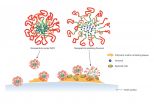(Press-News.org) The Pacific Northwest is dotted by small, low-lying, coastal cities where populations tend to cluster. These communities can be isolated and are susceptible to devastation from major storms that bring substantial wind, waves and storm surge. With climate change, it is anticipated that storms will only become more frequent and intense, signifying a need to understand how the areas will be affected.
David Hill, a researcher at Oregon State University, is focused on the hydrology and hydrodynamics in coastal areas, which represent the boundary between terrestrial and marine environments. His research on future levels of flooding in Tillamook Bay was published in the Journal of Geophysical Research in January 2015.
"This particular project is a blending of our interests in estuarine and coastal hydrodynamics and our interests in climate change," Hill said. "We're interested in getting a good quantitative understanding of the extreme water levels we can expect from coastal flooding."
Unlike the South or East coast of the United States, coastal flooding in the Pacific Northwest comes primarily from large waves generated by major storms instead of hurricanes.
"We get big storms here, it's not uncommon to see wave heights that are 10 meters," Hill said. "Those waves do a couple of things, they can overtop dunes and sea walls. There is also a curious effect where as those waves approach shore and break, they actually push the water up, creating a storm surge effect."
Storm surge is the abnormal rise of water generated by a storm, causing extreme flooding in coastal areas. It is costly, often leading to the damage or loss of houses and businesses, as well as the potential loss of life. In a report released by the Intergovernmental Panel on Climate Change (IPCC), climate scientists detailed how carbon emissions will impact future climate, and in turn sea level rise. These changes in climate will also lead to an increase in extreme storms and flooding in the future.
Hill and his team of researchers wanted to quantify exactly how flooding will change in the Pacific Northwest on a decadal to century time scale. The researchers developed a novel approach to the issue by using climate data from the IPCC and directly modeling all of the components that cause flooding at the coast including, waves, tides, winds blowing over the surface of the ocean and estuaries, precipitation, and stream flow.
Through an allocation with the National Science Foundation Extreme Science and Engineering Discovery Environment (NSF XSEDE), a national cyberinfrastructure that gives researchers access to advanced digital resources, Hill and his team use advanced computing at the Texas Advanced Computing Center (TACC) to perform their modeling.
"The models we need to simulate year after year of climate data are computationally intensive. They solve key physical equations that govern the transport of water and energy, which requires a fine grid in space and time," Hill said. "And at the conclusion of our modeling run, we have a multi-year data record of all of these important flooding variables -- the raw output is very large."
Hill has been a TACC user for many years; he began with the Lonestar supercomputer in 2007 and is now using Stampede, one of the most powerful supercomputers in the world.
"My research program changed quite a bit because of those initial projects with Lonestar. Having that kind of access was great because it allowed us to do all these things we couldn't do before," Hill said. "I ended up pushing a larger percentage of my research portfolio over towards these parallel computing model studies."
Results from Hill's study allowed the researchers to calculate extreme water levels for different locations in an estuarine environment for 10-year, 50-year, and 100-year periods. Then, the water levels were overlaid on a digital model of a particular area to identify the zones of inundation.
The findings highlight the need to reconsider flood maps that Oregon city planners use for development. Currently, the maps created for future flood zones only show a spatially uniform water elevation. However, Hill's main finding is that these assumptions are invalid. His models show that the level of inundation will vary greatly, even in small bays. According to Hill, another interesting finding was that future extreme water levels were due to more than sea level rise, as waves and tides will be amplified in the future.
Although the flood maps are designed to represent a small area, Hill believes this work could be replicated throughout Oregon and other states in the Pacific Northwest.
"Working with TACC through XSEDE and using supercomputers allowed us to test a hypothesis, and apply physical process based models to coastal areas," Hill said. "Now, with funding from the Oregon Sea Grant we are working to implement a new strategy and make these kind of results available to other areas in the Pacific Northwest."
INFORMATION:
PHILADELPHIA-- Penn Medicine researchers are continuing their work in trying to understand the mechanisms through which anesthetics work to elicit the response that puts millions of Americans to sleep for surgeries each day. Their most recent study looked at ketamine, an anesthetic discovered in the 1960s and more recently prescribed as an anti-depressant at low doses. Through collaboration with the University of Pennsylvania's department of Chemistry and scientists at the Duke University Medical Center, researchers at Penn's Perelman School of Medicine have identified ...
ALEXANDRIA, VA -- An updated clinical practice guideline from the American Academy of Otolaryngology--Head and Neck Surgery Foundation published today in Otolaryngology-Head and Neck Surgery identifies quality improvement opportunities and explicit actionable recommendations for clinicians managing adult sinusitis, including a greater focus on patient education and patient preference.
"More than ever before, there is a prominent role for shared decision-making between patients and clinicians when managing adult sinusitis--especially in deciding whether to use antibiotics ...
In 2006 construction began on a new shopping centre in Tulln. The works unearthed various archaeologically valuable objects that were salvaged during rescue excavations. Among these objects was also the complete skeleton of a large mammal.
Large mammal uncovered during excavations in Tulln
"The partly excavated skeleton was at first suspected to be a large horse or cattle," says archaeozoologist Alfred Galik from the Institute for Anatomy, Histology and Embryology at the University of Veterinary Medicine Vienna. "But one look at the cervical vertebrae, the lower jaw ...
Therapeutic agents intended to reduce dental plaque and prevent tooth decay are often removed by saliva and the act of swallowing before they can take effect. But a team of researchers has developed a way to keep the drugs from being washed away.
Dental plaque is made up of bacteria enmeshed in a sticky matrix of polymers--a polymeric matrix--that is firmly attached to teeth. The researchers, led by Danielle Benoit at the University of Rochester and Hyun Koo at the University of Pennsylvania's School of Dental Medicine, found a new way to deliver an antibacterial agent ...
People who apply eyeliner on the inner eyelid run the risk of contaminating the eye and causing vision trouble, according to research by a scientist at the University of Waterloo. This is the first study to prove that particles from pencil eyeliner move into the eye.
Dr. Alison Ng, at the Centre for Contact Lens Research at Waterloo, directed the study when she was at Cardiff University in Wales. The team's findings appear in Eye and Contact Lens Science and Clinical Practice, the official peer-reviewed journal of the Contact Lens Association of Ophthalmologists.
Dr. ...
If you are trying to have a baby, a good night's sleep is more important than ever. A new research report appearing in The FASEB Journal shows that the womb has its own "body clock" that needs to synchronize with the mother's body clock to ensure optimal conditions for fetal growth and development. The inability of a mother's body clock to synchronize with the womb's clock may be at least part of the reason why some women have difficulty carrying a pregnancy to full term. Specifically, the failed synchronization switches off body clock genes in cells lining the womb, which ...
ANCHORAGE, Alaska -- A team of scientists led by the U.S. Geological Survey found that polar bears, increasingly forced on shore due to sea ice loss, may be eating terrestrial foods including berries, birds and eggs, but any nutritional gains are limited to a few individuals and likely cannot compensate for lost opportunities to consume their traditional, lipid-rich prey -- ice seals.
"Although some polar bears may eat terrestrial foods, there is no evidence the behavior is widespread," said Dr. Karyn Rode, lead author of the study and scientist with the USGS. "In the ...
Washington, DC--Night owls are more likely to develop diabetes, metabolic syndrome and sarcopenia than early risers, even when they get the same amount of sleep, according to a new study published in the Endocrine Society's Journal of Clinical Endocrinology & Metabolism.
The study examined the difference between night and morning chronotypes, or a person's natural sleep-wake cycle. Staying awake later at night is likely to cause sleep loss, poor sleep quality, and eating at inappropriate times, which might eventually lead to metabolic change.
"Regardless of lifestyle, ...
Washington, DC--Exposure to the endocrine-disrupting chemical bisphenol A during pregnancy may raise a mother's susceptibility to weight gain and diabetes later in life, according to a new animal study published in the Endocrine Society's journal Endocrinology.
A chemical used to manufacture plastics and epoxy resins, bisphenol A (BPA) is found in a variety of consumer products, including plastic bottles, food cans and cash register receipts. The U.S. Centers for Disease Control and Prevention have estimated that more than 96 percent of Americans have BPA in their bodies.
BPA ...
Cambridge, Mass. April 1, 2015-- A collaborative study between researchers from the Broad Institute of MIT and Harvard, Massachusetts Institute of Technology, and the National Center for Biotechnology Information of the National Institutes of Health (NIH-NCBI) has identified a highly efficient Cas9 nuclease that overcomes one of the primary challenges to in vivo genome editing. This finding, published today in Nature, is expected to help make the CRISPR toolbox accessible for in vivo experimental and therapeutic applications.
Originally discovered in bacteria, the CRISPR-Cas9 ...




